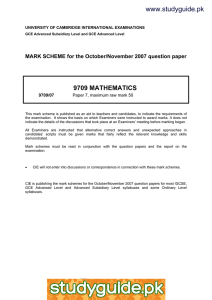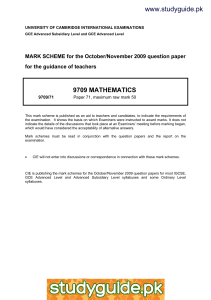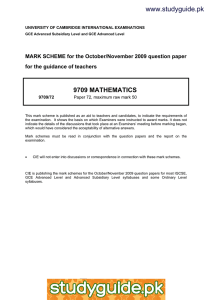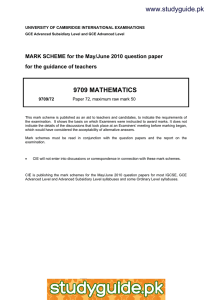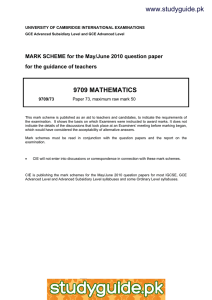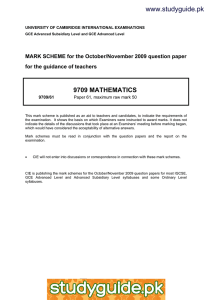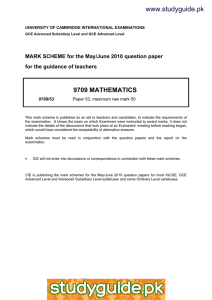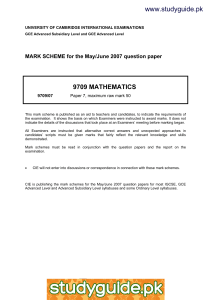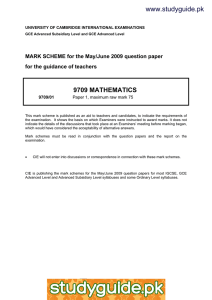www.studyguide.pk 9709 MATHEMATICS
advertisement
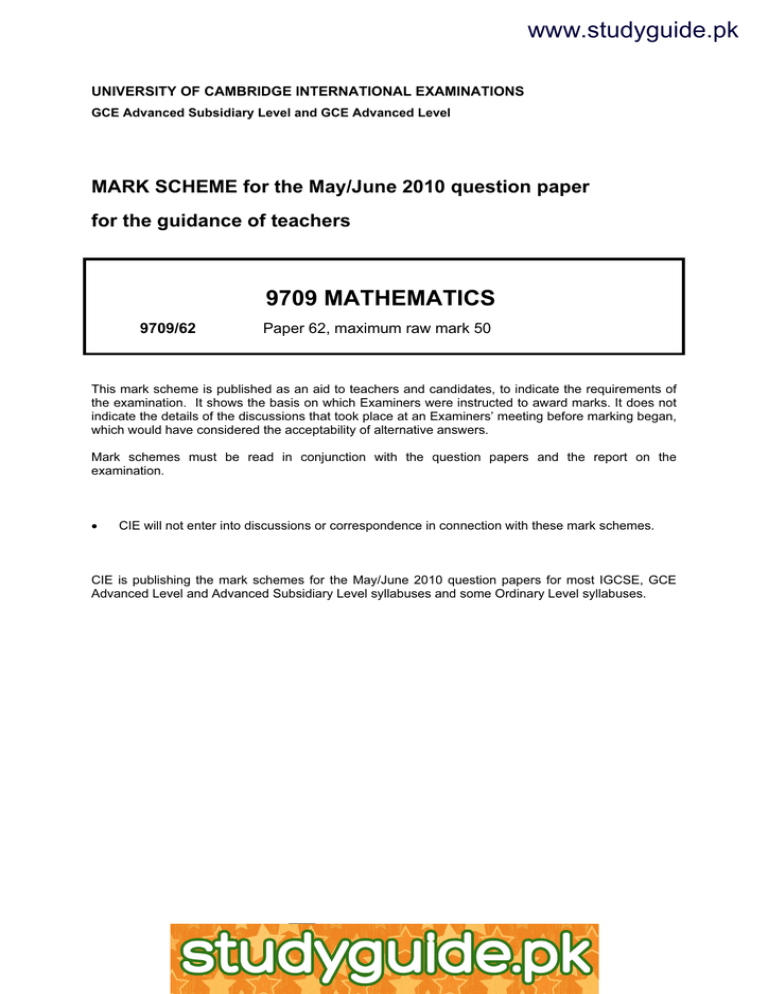
www.studyguide.pk UNIVERSITY OF CAMBRIDGE INTERNATIONAL EXAMINATIONS GCE Advanced Subsidiary Level and GCE Advanced Level MARK SCHEME for the May/June 2010 question paper for the guidance of teachers 9709 MATHEMATICS 9709/62 Paper 62, maximum raw mark 50 This mark scheme is published as an aid to teachers and candidates, to indicate the requirements of the examination. It shows the basis on which Examiners were instructed to award marks. It does not indicate the details of the discussions that took place at an Examiners’ meeting before marking began, which would have considered the acceptability of alternative answers. Mark schemes must be read in conjunction with the question papers and the report on the examination. • CIE will not enter into discussions or correspondence in connection with these mark schemes. CIE is publishing the mark schemes for the May/June 2010 question papers for most IGCSE, GCE Advanced Level and Advanced Subsidiary Level syllabuses and some Ordinary Level syllabuses. www.XtremePapers.net www.studyguide.pk Page 2 Mark Scheme: Teachers’ version GCE AS/A LEVEL – May/June 2010 Syllabus 9709 Paper 62 Mark Scheme Notes Marks are of the following three types: M Method mark, awarded for a valid method applied to the problem. Method marks are not lost for numerical errors, algebraic slips or errors in units. However, it is not usually sufficient for a candidate just to indicate an intention of using some method or just to quote a formula; the formula or idea must be applied to the specific problem in hand, e.g. by substituting the relevant quantities into the formula. Correct application of a formula without the formula being quoted obviously earns the M mark and in some cases an M mark can be implied from a correct answer. A Accuracy mark, awarded for a correct answer or intermediate step correctly obtained. Accuracy marks cannot be given unless the associated method mark is earned (or implied). B Mark for a correct result or statement independent of method marks. • When a part of a question has two or more "method" steps, the M marks are generally independent unless the scheme specifically says otherwise; and similarly when there are several B marks allocated. The notation DM or DB (or dep*) is used to indicate that a particular M or B mark is dependent on an earlier M or B (asterisked) mark in the scheme. When two or more steps are run together by the candidate, the earlier marks are implied and full credit is given. • The symbol √ implies that the A or B mark indicated is allowed for work correctly following on from previously incorrect results. Otherwise, A or B marks are given for correct work only. A and B marks are not given for fortuitously "correct" answers or results obtained from incorrect working. • Note: B2 or A2 means that the candidate can earn 2 or 0. B2/1/0 means that the candidate can earn anything from 0 to 2. The marks indicated in the scheme may not be subdivided. If there is genuine doubt whether a candidate has earned a mark, allow the candidate the benefit of the doubt. Unless otherwise indicated, marks once gained cannot subsequently be lost, e.g. wrong working following a correct form of answer is ignored. • Wrong or missing units in an answer should not lead to the loss of a mark unless the scheme specifically indicates otherwise. • For a numerical answer, allow the A or B mark if a value is obtained which is correct to 3 s.f., or which would be correct to 3 s.f. if rounded (1 d.p. in the case of an angle). As stated above, an A or B mark is not given if a correct numerical answer arises fortuitously from incorrect working. For Mechanics questions, allow A or B marks for correct answers which arise from taking g equal to 9.8 or 9.81 instead of 10. © UCLES 2010 www.XtremePapers.net www.studyguide.pk Page 3 Mark Scheme: Teachers’ version GCE AS/A LEVEL – May/June 2010 Syllabus 9709 Paper 62 The following abbreviations may be used in a mark scheme or used on the scripts: AEF Any Equivalent Form (of answer is equally acceptable) AG Answer Given on the question paper (so extra checking is needed to ensure that the detailed working leading to the result is valid) BOD Benefit of Doubt (allowed when the validity of a solution may not be absolutely clear) CAO Correct Answer Only (emphasising that no "follow through" from a previous error is allowed) CWO Correct Working Only – often written by a ‘fortuitous' answer ISW Ignore Subsequent Working MR Misread PA Premature Approximation (resulting in basically correct work that is insufficiently accurate) SOS See Other Solution (the candidate makes a better attempt at the same question) SR Special Ruling (detailing the mark to be given for a specific wrong solution, or a case where some standard marking practice is to be varied in the light of a particular circumstance) Penalties MR –1 A penalty of MR –1 is deducted from A or B marks when the data of a question or part question are genuinely misread and the object and difficulty of the question remain unaltered. In this case all A and B marks then become "follow through √" marks. MR is not applied when the candidate misreads his own figures – this is regarded as an error in accuracy. An MR–2 penalty may be applied in particular cases if agreed at the coordination meeting. PA –1 This is deducted from A or B marks in the case of premature approximation. The PA –1 penalty is usually discussed at the meeting. © UCLES 2010 www.XtremePapers.net www.studyguide.pk Page 4 1 2 Mark Scheme: Teachers’ version GCE AS/A LEVEL – May/June 2010 B1 B1 [2] (ii) median B1 [1] (iii) mode inappropriate because it is 10 and this is the lowest value. mean inappropriate because it is affected by the outlier (of 48). B1 Sensible reason allow if seen in (ii) B1 [2] Sensible reason allow if seen in (ii) not ‘outliers’ in plural M1 Standardising, no cc, no sq rt A1 [2] Rounding to correct answer M1 Bin expression with ∑ powers = 6, 6Cx, p + q = 1. Reasonably correct unsimplified expression ft their (i) Rounding to correct answer (i) P(x > 10.9) = P( z > 10.9 − 11 ) 0.095 (ii) P(at least 2 < 10.9) = 1 – P(0, 1) = 1 – (0.8538)6 – 6C1(0.1462)(0.8538)5 A1ft = 0.215 A1 [3] median A = 2.0 – 2.1 or x A = 2.0 – 2.1 median B = 3.8 – 3.9 or x B = 3.4 – 3.5 M1 A1 Country B has heavier babies on average B1 IQ range A = 2.4 – 1.5 = 0.9 or sd = 0.5 – 0.7 IQ range B = 4.5 – 2.2 = 2.3 or sd = 1.2 – 1.4 M1 A1 A1 [6] Country B has greater spread of weights 4 For finding medians or using mid-pts and freqs to find means, or seen on 2 boxplots Correct medians or means for A and B Correct statement allow ’...higher median…’ etc. Finding spreads by IQ range or range or sd or 2 box-plots Correct IQ range or sd for A and B (±0.1 kg) or correct IQR on box-plots Correct statement 2µ − µ (i) P (X < 2 µ) = P z < σ M1 = P(z < µ/σ) = P(z < 5/3) A1 Standardising, and attempt to get , no sq 1 variable, no cc, no ±5/3 seen oe = 0.952 A1 [3] Rounding to correct answer M1 standardising attempt resulting in z Y – some µ/σ µ /3− µ allow ± σ ±1.047 seen µ − 2µ (ii) P X < = P z < 3 3σ − 2µ = 1.047 3σ µ = –1.57σ 5 Paper 62 (i) x = 18.9 (132/7) sd = 12.3 = P(z > –1.0526) = 0.8538 (0.854) 3 Syllabus 9709 B1 (i) (2,12), (3, 8), (4, 6), (6, 4), (8,3), (12,2) P(Q) = 6/144 (1/24) (0.0417) A1 [3] correct single number, answer must have a minus sign and µ = …..σ M1 Listing or picking out at least 3 different options from a 12 by 12 (mult) table or seeing 3, 4, 5 or 6/144 Correct answer A1 [2] © UCLES 2010 www.XtremePapers.net www.studyguide.pk Page 5 Mark Scheme: Teachers’ version GCE AS/A LEVEL – May/June 2010 (ii) P(both > 8) = 1/3 × 1/3 M1 A1 [2] = 1/9 = P(R) (16/144) 6 B1* B1dep [2] o.e. in words (iv) P(R and Q) = 0 ≠ P(R) × P(Q) or P(R|Q) = 0, ≠ P(R) No, not independent B1* o.e. in words B1dep [2] (i) B1 x 0 1 2 P(X = x) 1/7 4/7 2/7 B1 B1 [3] (ii) E(X) = 8/7 (1.14) AG B1 Var(X) = 12/7 – (8/7)2 M1 A1 [3] P (G ∩ NA) P ( NA) 2 / 5 ×1/ 4 = 2 / 5 × 1 / 4 + 3 / 5 × 9 / 10 (iii) P(G | NA) = 5 (0.156) 32 M1 Attempt at P(NA) or P(A) in form of summing two 2-factor products, seen anywhere Correct unsimplified denominator of a fraction Correct answer (i) 362880 (363000) B1 [1] (ii) PG or GP in 8! × 2 = 80640 or 7/9 of (i) M1 (iii) 9P3 or 9C3 × 3! or 9!/6! B1 A1ft [3] M1 A1 [2] = 504 (iv) 8C2 × 3! or 504 – 8C3 × 3! or 8P2 × 3 M1 A1 [2] = 168 (v) PG and x in 7 × 2 × 2 ways = 28 Answer 504 – 28 = 476 Legitimate correct given answer rounding to 1.14 Correct method with mean2 subt numerically no dividing by anything Correct final answer Attempt at P(G ∩ NA) or P(G ∩ A) as numerator of a fraction A1 [4] 362880 – 80640 = 282240 0, 1, 2 only in table or listed with some prob 3, 4… if in table must have blank or 0 for prob One correct probability All correct M1 A1 = Paper 62 Squaring a sensible prob or picking out 12 – 25 options Correct answer (iii) since P(R and Q) = 0 Yes, R and Q are exclusive = 20/49 (0.408) 7 Syllabus 9709 M1 A1 [2] Considering together and also subtracting from their (i) or using probabilities 8! × 2 or 80640 seen oe correct answer ft 40320 only 9 P3 or 9C3 oe seen allow extra multiplication correct final answer 8 Cx or 8Px seen allow extra mult, or (iii)/9 or (iii)/3 correct final answer x × 2 × 2 seen or their (iii) – 7 or 7C1 or 7 C2 correct answer © UCLES 2010 www.XtremePapers.net

